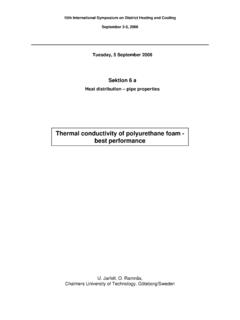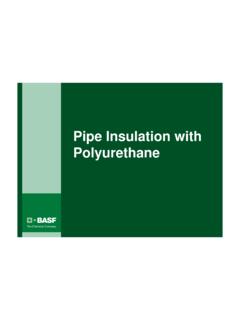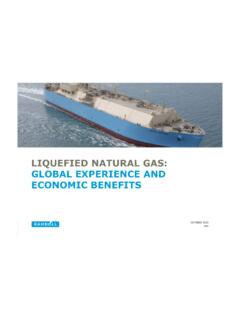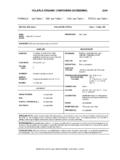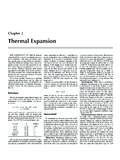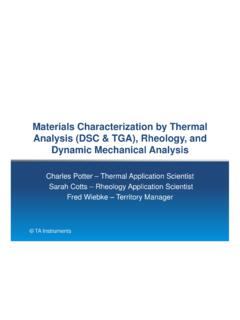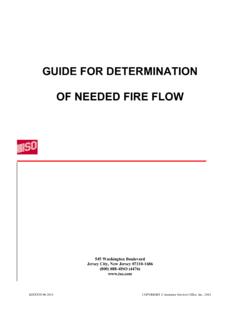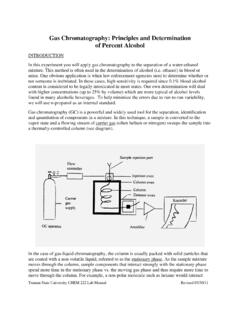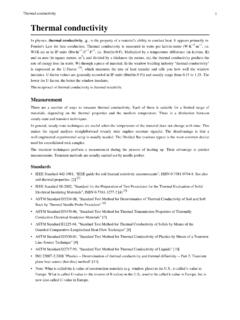Transcription of Thermal conductivity of polyurethane foam - best …
1 10th International Symposium on District Heating and CoolingSeptember 3-5, 2006 Tuesday, 5 September 2006 Sektion 6 aHeat distribution pipe propertiesU. Jarfelt, O. Ramn s, Chalmers University of Technology, G teborg/SwedenThermal conductivity of polyurethane foam -best performanceThermal conductivity of polyurethane foam Best performance Ulf Jarfelt1 Olle Ramn s2 1 Department of Building Technology 2 Department of Chemical Environmental Science Chalmers University of Technology SE- 412 96 G teborg, Sweden Introduction polyurethane (PU) foam has been used for pre-insulated district heating pipes for many years. Originally CFC-11 (Freon 11) was used as a blowing agent for this type of foam. Due to the very low Thermal conductivity of CFC-11 the insulating properties of the foam became excellent. After the ban of CFC-11 in the 1990 s there has been a very hard competition to find alternative blowing agents and upgraded material properties to achieve an insulation capacity in the same magnitude as earlier.
2 The development work has up till today resulted in a PU-foams with smaller cells and lower densities than earlier and with cyclopentane in combination with carbon dioxide as blowing agent. The vapour pressure of cyclopentane is 34 kPa at 20 C and the amount of cyclopentane in gas phase will therefore be limited at room temperature. When the foam is produced the cell gas pressure needs to be at least just over atmospheric level (100kPa). Consequently the cell gas mixture will often be saturated with cyclopentane (about 34 % by volume at 20 C) but the main gaseous compound will be carbon dioxide, originating from the chemical reaction between isocyanate and water. In some cases isopentane, that has a lower vapour pressure than cyclopentane, is also added. The Thermal conductivity of an insulating foam depends on the conductivity of the cell gas mixture, the conductivity of the solid polymer and the radiation between cells.
3 The radiation of heat has been reduced by making the cells smaller and the conduction of heat in the solid polymer has been reduced by decreasing the foam density. However, conduction in the cell gas mixture stands for the main part of the Thermal conductivity of a foam. About 65-80% of the insulation capacity of a foam is due to the cell gas mixture while cell size and density stands for the rest. A number of requirements have been put on the PU-foam used for district heating pipes. One of the top priorities is the Thermal conductivity and it is therefore important that the 1(11) accuracy of the conductivity measurements is high. The requirements for determination of the Thermal conductivity of pre-insulated pipes are stated in EN253:2003. However the test procedure is quite complicated and the spread in results are some times too high.
4 In the European standardization work, CEN/TC107, two Round Robin projects have been conducted in order to minimize the deviation between laboratories both regarding test procedure and equipment. At this moment no test procedure is described for flexible pipes. There is struggle to reduce the Thermal conductivity to a minimum. How far can we go? In this project we have studied the Thermal conductivity of six different PU-foams for pre-insulated as well as for flexible pipes. The foams are of the latest generation and manufactured by three different raw material producers. Experimental All relevant material properties concerning Thermal conductivity were determined. Cell size and cell structure were determined by scanning electron microscopy (SEM), cell gas content by cell gas analysis by gas chromatography [1] and Thermal conductivity by measurements in a Heat Flow Apparatus [2].
5 SEM photos of the six different PU-foams are shown in Figure 1. Foams with normal cellular structure, cell size 0,25-0,30 mm Standard foam for DH-pipes (Type A) Standard foam for DH-pipes (Type B) 1 mm 1 mm 2(11) Foams with microcellular structure, cell size 0,10-0,20 mm Semi-flexible fpe C) 1 mm 1 mm oam. (Ty Microcellular rigid foam (Type D) Semi-flexible foam (Type E) Semi-flexible foam (Type F) 1 mm 1 mm 1 mm Figure 1. SEM photos of the six different PU-foams. Type A and B are foams designed for traditionally (non-continuous) made pre-insulated district heating pipes and type C-F are microcellular foams for rigid and flexible pipes. Calculations The Thermal conductivity of PU foam is due to three modes of heat transfer, conduction in the cell gas mixture, conduction in the solid polymer and radiation between the cell walls.
6 Radiationsolidgastotal ++= The Thermal conductivity due to conduction in the cell gas mixture has been calculated using Wassiljewa s equation [3]. 3(11) == =ninjijjiigasAyy11 where 2124121181 + +=jijitrjtriijMMMMA (Eq. 1) Input data: Gas 10 (W m-1 K-1) 50 (W m-1 K-1) Molecular weight Air [4] 0,0250 0,0282 30 Carbon dioxide [4] 0,0157 0,0184 44 Cyclopentane [5] 0,0127 0,0155 70 The conduction of heat in the solid PU structure is a combination of the heat flow in the cell walls and the struts. The Thermal conductivity ( PU) of the solid PU polymer from crushed foam samples is reported to be 0,26 W m-1 K-1 [6] and the fraction of solids in the struts (fs) has been reported to 0,8 [7]. The Thermal conductivity [7] can be described by ()()( + =1132131sPUsPUconductionff) where sf =1 (Eq.)
7 2) The radiation between the cell walls has been calculated by the Rossland equation with the extinction coefficient of the cell wall material Kw = 60000 m-1 suggested by Glicksman [7]. KTradiation =3163 where ()wsfssfsKfdfK + = 110,4 (Eq. 3) Symbols: K Extinction coefficient m-1M Molecular weight kg kmole-1T Temperature K d Cell diameter m fs Fraction of solid in strut fs=0,8 - yiMolar fraction of gas - Volume fraction of voids or cell interiors - Thermal conductivity W m-1 K-1 fDensity of PU foam kg m-3 sDensity of PU polymer kg m-3 Stephan Boltzman constant = 5,7 10-8W m-2 K-4 4(11) The results from the calculation model can be compared with measurements of the total Thermal conductivity using the heat flow apparatus.
8 The input parameters used in the calculations are taken from the determination of cell gas content, cell size measurements by SEM and density measurements. The influence of the foam density on the Thermal conductivity of a microcellular cyclopentane blown foam (cell size = 0,15mm) is shown in Figure 2. 0,0000,0050,0100,0150,0200,0253040506070 80 Density (kg/m3) Thermal conductivity (W/(mK))gassolidradiation Figure 2. Calculated contributions of radiation, conduction in cell gas mixture and PU matrix to the Thermal conductivity of a cyclopentane blown PU-foam with a cell size of 0,15 mm which corresponds to a microcellular foam. 5(11) Results Table 1. Measurements of Thermal conductivity . Foam Density kg m-3 Cell size* mm 10 W m-1 K-1 x10-3 40 W m-1 K-1 x10-3 A Rigid foam 64 0,26-0,31 22,16 - B Rigid foam 55 0,29-0,31 22,10 25,51 C Microcellular Rigid 68 0,15-0,25 21,32 24,43 D Microcellular Semi-flexible 66 0,12-0,15 20,24 - E Microcellular Semi-flexible 72 0,10-0,15 21,85 25,18 F Microcellular Semi-flexible 57 0,18-0,22 21,06 24,59 * measured in two perpendicular directions Table 2.
9 Measurements of cell gas content. Foam Total Pressure kPa Oxygen Vol-% Nitrogen Vol-% Carbon dioxide Vol-% Cyclo- pentane Vol-% Iso-pentane Vol-% Water vapor Vol-% Others Vol-% A 117 1,6 0,9 61 34 - 1,0 0,8 B 126 0,2 0,8 65 32 2 0,4 0,5 C 105 0,3 1,1 44 35 16 1,6 1,5 D 87 1,5 1,5 61 32 - 1,0 3,1 E 98 0.
10 5 1,9 61 35 - 0,6 0,9 F 104 0,2 0,9 67 30 1 0,7 0,5 at temperature of analysis = 24 C 6(11) 0,020,0220,0240,0260,02801020304050 Temperature (C) Thermal conductivity (W/(mK))ABCEFF igure 3. The influence of temperature on the Thermal conductivity is represented by a straight line in the temperature range 10 - 40 C. The relationship is based on measurements on 5 foam samples. The Thermal conductivity can be written: (T)= 0,02064 + 11,28 10-5 T (W m-1 K-1) As the Thermal conductivity strongly depends on the temperature it is important to establish this relation. For most PU-samples the Thermal conductivities have been determined at various temperatures (Figure 3).
